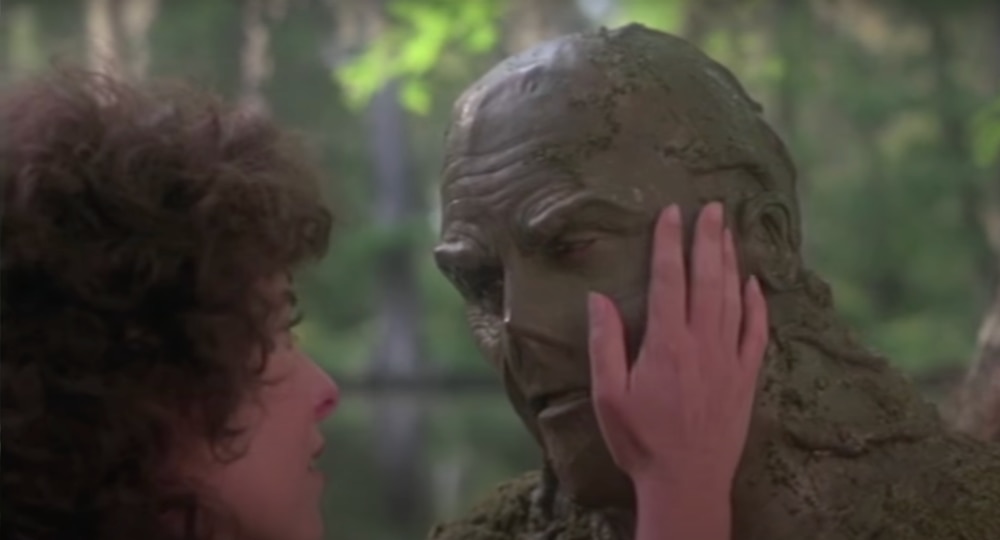Create a free profile to get unlimited access to exclusive videos, sweepstakes, and more!
'Swamp Thing' at 40: Does Wes Craven's first and only comic book movie still hold up?
We're celebrating the 40th anniversary of the Scream director's DC Comics creature feature.

Swamp Thing, Wes Craven's film based on the DC Comics series of the same name, came at a time when comic book movies were in the $0 billion dollar phase of their existence, and when rights holders could take a chance on a horror director like Craven to make a comic book adaptation.
In 1982, Swamp Thing as a character was not yet the literary horror icon he would become in the hands of creators like Alan Moore, Craven was not yet the Hollywood icon who gave us A Nightmare on Elm Street a few years later, and comic book movies in general were a far cry from what they would become in the 1990s and 2000s after Tim Burton's Batman broke through.
That's a fascinating position from which to view the film, which turns 40 this month, particularly in light of the current comic book movie landscape and the current reverence for Craven exhibited by horror fans everywhere and projects inspired by his work, like 2022's Scream. For Craven, Swamp Thing was a proving ground, a chance to deliver something bigger than the exploitation cinema he was then known for and move on to bigger genre pieces in the coming years. He took on the film not because he had some great reverence for the character, who was then only a decade old, but because he saw something he could execute, and perhaps something he could elevate.
So, knowing what we know now about what Craven would become, what Swamp Thing would become, and what comic book movies would become, how does Swamp Thing hold up four decades later? Though it built a following as a VHS staple in the 1980s on the strength of its creature feature appeal, viewing the film now is a slightly more reverent experience, guided by the feeling that Craven somehow found the perfect bridge between the filmmaker he'd been and the filmmaker he was going to be, and that he somehow delivered that through a monster in a green rubber suit.
The setup for the film plays now like an unapologetically comic book origin story, pulled at least somewhat faithfully from Len Wein and Berni Wrightson's original concept. Dr. Alec Holland (Ray Wise) is a brilliant scientist working on a formula that will supercharge plant growth and, hopefully, solve poverty, when the henchmen of the evil Arcane (Louis Jourdan) barge in to steal it. The formula explodes all over Alec, he falls into the swamp around his lab, and the bright green ooze transforms him into the titular bipedal swamp creature. As Arcane works to get his mind around Holland's original formula with the end goal of world domination, the Swamp Thing (played by Dick Durock post-transformation) and his assistant Alice Cable (Adrienne Barbeau) fight to put a stop to Arcane's schemes and, in the process, maybe find a way to bring Alec back.
So right away you have a hero, a villain, a love interest, and a transformation that sets things on a recognizable comics-driven path, making Swamp Thing a fairly conventional approach to the character as he existed then. Though certain visual effects feel dated, the pacing might seem a bit slow compared to modern comic book storytelling, and the horror elements might feel a little lacking through the lens of modern Swamp Thing stories, it's remarkable how comfortable this feels for Craven right from the beginning. This is a guy who was best known at the time for all-out, mean-spirited horror films like The Last House on the Left and The Hills Have Eyes, and yet he slips completely comfortably into the almost Universal Horror-inspired tone of the whole thing, both as a writer and a director. It's a glimpse at the often overlooked genre versatility he would later employ in everything from supernatural slashers to voodoo stories.
It would have been easy for this film and its straightforward, pulpy approach to the source material to lose something of Craven's overall personality along the way, particularly when the guy in the green suit starts to get a lot of screen time, but even there, Swamp Thing manages to feel very much like a Wes Craven original. It starts with a half-sunken church that's been converted into Alec Holland's secretive lab, and continues as Holland himself waxes poetic about the versatility of life in the swamp, its beauty, and the almost religious way in which he seems to meditate on its vibrance.
For Craven, whose spiritual influences and meditations on human cruelty and survival were always front and center in his best films, it's a chance to put his own stamp on the material, and in his own way presage things that creators like Alan Moore would later do with the character. For all its almost B-movie plotting, there's a lot of reverence, and a lot of patience, in the way Craven approaches the narrative. That means that, even when the creature suits might look especially suit-like and the visuals leave a little something to be desired, it feels like deft hands are at work behind the camera.
Swamp Thing still doesn't necessarily rank among Craven's best films. It doesn't have the raw drive of The Hills Have Eyes or the lightning-in-a-bottle magic of A Nightmare on Elm Street or the intellect of Wes Craven's New Nightmare and Scream. What it does have, though, is the undeniable energy of a creator embracing his assignment, pouring as much of himself as possible into it, and producing something that remains memorable, even four decades later. It's not the brightest spot in the Craven filmography, but there's still a spark there, and given what we know about the flame that spark would eventually become, that's still a fascinating thing.


























